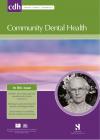Community Dental Health

- Cover Date:
- December 2011
- Print ISSN:
- 0265 539X
- Vol:
- 28
- Issue:
- 4
Evaluation of a preventive program based on caries risk among mentally challenged children using the Cariogram model
Objectives: To assess the caries risk and to evaluate the risk based preventive program at the end of 10 months amongst the mentally challenged children using the Cariogram model. Basic research design: Longitudinal field trial with before and after comparison. Participants: 54 children (7-17years old) with mild to severe mental disability constituted the study sample. Clinical setting: Brahmadutta School, for the mentally challenged children situated in Pimpri (Maharashtra) India. Interventions: Phase I: Information of the Cariogram parameters (caries experience, diet content, diet frequency, plaque amount, mutans streptococci, fluoride program, saliva secretion and saliva buffer capacity) were collected, which were used to generate the individual caries profile, based on which the children were divided into 5 risk groups. Phase II: Risk based preventive program was implemented. Phase III: At the end of 10 months, caries profile was generated again. Main outcome measures: The effectiveness of the preventive program was assessed by comparing the baseline and follow-up caries profile. Wilcoxon Signed Ranks test was used for statistical analysis. Results: As compared to the baseline, there was a 57% increase in the number of children in “low caries risk group†and for the caries risk factors diet content, diet frequency, plaque amount and Mutans streptococci count had significantly lower values. At follow-up, only 4 new carious lesions developed. Conclusion: The preventive program was effective in improving the caries risk factors and increasing the “chance to avoid caries†from a mean of 44% to 87%.
Key words: Cariogram, mentally challenged children, risk based preventive program, India
- Article Price
- £15.00
- Institution Article Price
- £
- Page Start
- 286
- Page End
- 291
- Authors
- Y.B. Patil, S. Hegde-Shetiya, P.V. Kakodkar, R. Shirahatti
Articles from this issue
- Title
- Pg. Start
- Pg. End
- Why has oral health promotion and prevention failed children requiring general anaesthesia for dental extractions?
- 255
- 258
- Predictors of utilisation of dental care services in a nationally representative sample of adults
- 269
- 273
- Applicability of both dentist and patient perceptions of dentists’ explanations to the evaluation of dentist–patient communication
- 274
- 279
- Evaluation of a preventive program based on caries risk among mentally challenged children using the Cariogram model
- 286
- 291
- The effect of a modified fluoride toothpaste technique on buccal enamel caries in adults with high caries prevalence: a 2-year clinical trial
- 292
- 296
- Association of clinical oral health status with self-rated oral health and GOHAI in Japanese adults
- 297
- 300
- Prevalence of periodontopathogens in a black Brazilian secluded community matched with a black urban population
- 301
- 304
- Incisor trauma in a Turkish preschool population: Prevalence and socio-economic risk factors
- 308
- 312
- Malocclusion and orthodontic treatment need measured by the Dental Aesthetic Index and its association with dental caries in Indian schoolchildren
- 313
- 316
